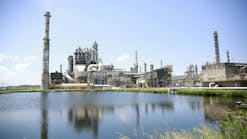Japan Petroleum Exploration Co. Ltd. (Japex) has devised a low-cost way to deliver LNG to remote markets by making use of existing railways. Here, a 30 ft, 10-tonne capacity LNG container-developed by Japex, Air Water Inc., and Japan Oil Transportation Co. Ltd.-is hoisted from a flatbed truck to be placed on a railcar. Photo courtesy of Japex.
Japan Petroleum Exploration Co. Ltd. (Japex) has developed a new method for transporting LNG to Japan's domestic markets.
This system, which makes use of existing railways, is a safe, reliable, and low-cost method of transporting LNG, according to Japex.
The company also deems its new system capable of being adapted for use in other countries, such as China or India, where forecasts call for a flurry of new LNG import projects in the coming decade (see special reports, OGJ, June 5, 2000, p. 60; and OGJ, June 19, 2000, p. 62).
Historically, Japex has transported LNG as regasified natural gas via its pipeline system or as LNG by using tank trucks-also referred to as the "LNG satellite system." Although effective in areas where transport via pipeline is not economically feasible, LNG transport through the satellite system carries generally higher costs.
The higher cost, says Japex, is due to Japan's high-pressure gas regulations governing transport by truck, which call for at least two drivers per truck for transporting LNG over distances greater than 200 km on conventional surface roads and 340 km on highways.
Increased costs have all but eliminated the potential for deliveries of LNG to users beyond these distances. In fact, all of Japex's existing satellite customers are within a 190-km radius of its supply base, it says.
The new system
Japex transported its first LNG container via rail from its Niigata terminal to Kanazawa terminal on Mar. 15, 2000. Since then, Japex has signed contracts with three customers, all located more than 350 km from the LNG terminal.
At the core of the system is a specially designed LNG container developed by Japex, Air Water Inc., and Japan Oil Transportation Co. Ltd. The 30-ft long container can carry 10 tonnes of LNG; including its cargo, a full tank weighs 20 tonnes.
Operation of the new system consists of three steps.
First, the tanks are transported from Japex's LNG terminal to the nearest freight terminal by a trailer. Containers are then loaded onto a train for transport to a market area. Finally, tanks are reloaded onto a trailer and delivered to the customer's site for regasification.
With a combination of trailers and existing railways, says Japex, both initial costs and operational spending are kept to a minimum. In addition, reliability is improved, as rail transport is generally more reliable even during times of severe weather, says Japex, especially in areas of northern Japan, where heavy snowfall and icy roads can thwart deliveries via truck.
Japex intends to market 5,000 tonnes of LNG in 2000, using this new rail method of delivery, and expects to increase the volume to 30,000 tonnes/year by 2004.


